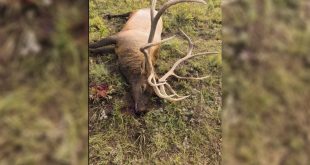By Dan Carlson
Hunters understand that the impact of weather on big-game animals is crucial year-round and not limited to the last four months of the year. What’s happening right now in the atmosphere will have considerable influence on both the quality of horn and antler growth and the habitat our prey dwells in. For those planning hunts in Colorado, Utah, Arizona and New Mexico later this year, the difference between excellent and marginal hunts will depend on which side of a very distinct line on the map you plan to go.
This is an exciting time to be a meteorologist because several fairly recent developments are simultaneously increasing our knowledge about how the planet’s oceans, atmosphere and apparent relationship to solar cycles have increased both accuracy and confidence in long-range forecasting, while at the same time, Nature throws us enough curving fast balls to keep us humble. So far, the forecasts you’ve read in Eastmans’ magazines about moisture and browse conditions through the summer have been spot on. But now some weird things are happening that won’t necessarily change them, but are likely to drive them home like tent stakes into clay.
El Nino, the cyclical warming of Pacific surface water temperatures, typically intensifies during winter and weakens in summer. Last winter a weak El Nino setup established a mild protective ridge in the atmosphere west of the Continental Divide where snowfall was anemic at best. The same pattern set up a trough over the nation east of the Mississippi River where periods of bitter cold were punctuated by excessive snowfall in the Northeast. But this summer, El Nino conditions are strengthening. That’s not supposed to happen. And water temperatures well above normal along the West Coast down to South America will have a profound impact on weather in the Southwestern U.S.
Look at a map of the country. Mentally draw a straight line from Spokane, Washington to Tucson, Arizona. If weather does what I think it will from now until hunting season, everyplace west of that line is going to see drought intensify and anyplace that’s now dry east of that line will see drought eradicated. That’s because conditions will be very similar to last summer when several Pacific hurricanes formed off the west coast of the Baja Peninsula and recurved northeast up the Arizona/New Mexico border into Colorado. The result was excessive rainfall and even flash flooding in extreme eastern parts of Arizona and Utah with above-average rainfall across much of Colorado and New Mexico.
I was recently in Colorado and saw firsthand how rivers and streams east of the Front Range and north of I-70 are already out of their banks. There was also still plenty of snowpack in the higher elevations from the Wyoming border down through the northern Colorado Rockies. With above-average rains and below-average temperatures forecast across Colorado through August, vegetation of all types will flourish and game animals will have plenty to feed on. From prairie pronghorns to high-mountain elk, the headgear by summer’s end should be impressive. Bears will also have berries in abundance with some big bruins about for those fortunate enough to have tags.
New Mexico’s weather has really turned around over the last two years. Areas of the state east of the mountains that were bone dry should be done with drought completely soon with the rest of the state following by August as that moisture from tropical systems moves up from Mexico. Forage is coming back nicely, especially in the northeast half of the state this spring and on the adjacent High Plains as well. This fall we should see some of the best bulls and bucks to come out of New Mexico in years, thanks to cool and damp weather all summer long.
 Favorable conditions for forage and habitat will extend west to Utah’s Wasatch Range and its western foothills, but west of the high mountains conditions will become progressively worse. Moderate to severe drought should set in as summer progresses over the west half of Utah, making the best habitat for antler development east of a line from Bryce Canyon to the Great Salt Lake.
Favorable conditions for forage and habitat will extend west to Utah’s Wasatch Range and its western foothills, but west of the high mountains conditions will become progressively worse. Moderate to severe drought should set in as summer progresses over the west half of Utah, making the best habitat for antler development east of a line from Bryce Canyon to the Great Salt Lake.
Arizona’s best habitat will be near the New Mexico border and from the north-central border with Utah north of the Grand Canyon east to the Four Corners area. The rest of the state is forecast to experience worsening drought through the summer. The closer you can hunt to the state’s east and northeast borders, the better conditions will be for antler- and horn-growing forage.
To summarize, hunting will be superb in Colorado this year and very good in New Mexico too. Utah will be okay in extreme eastern areas but hunters will have to work hard for success in much of Arizona.
 Eastmans' Official Blog | Mule Deer, Antelope, Elk Hunting and Bowhunting Magazine | Eastmans' Hunting Journals
Eastmans' Official Blog | Mule Deer, Antelope, Elk Hunting and Bowhunting Magazine | Eastmans' Hunting Journals







Not to sure about AZ having a bad antler growth year. We have received over 300 percent of our average precipitation in a lot of the best elk units in the state. It’s greener than ever and there is water everywhere. Monsoon moisture is already forecast for next week which usually last all July and August.